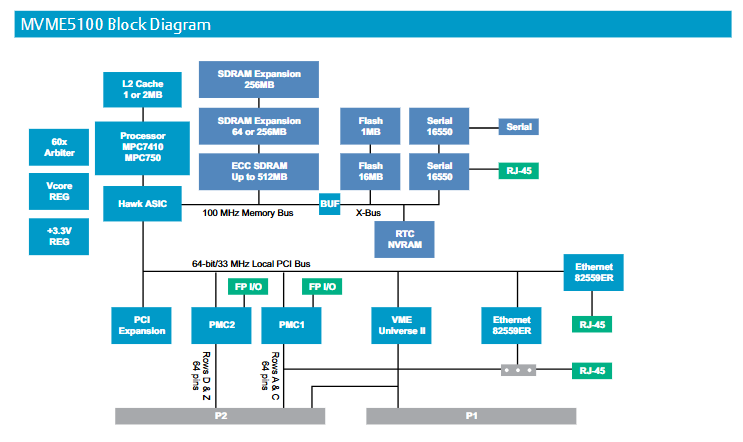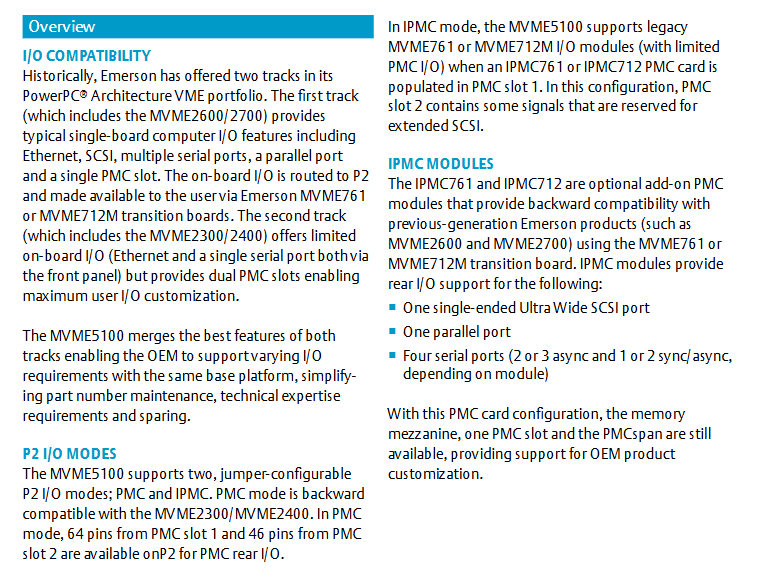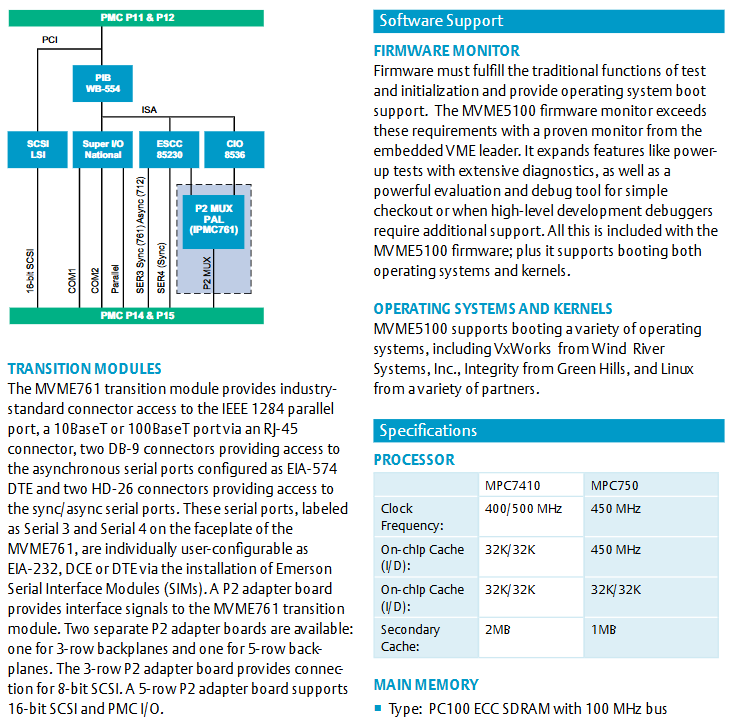Emerson MVME5100 Series VME Bus Processor Module
Emerson MVME5100 Series VME Bus Processor Module
Product core positioning
MVME5100 is a high-performance embedded VME bus processor module launched by Emerson Network Power. Based on the PowerPlus II architecture, it is positioned as a highly reliable computing solution for "business critical" fields such as defense aerospace, industrial automation, and medical equipment. It combines the rich I/O functions of traditional single board computers with the flexibility of dual PMC expansion slots, supports multi operating system and complex peripheral adaptation, and can achieve supercomputing level performance (such as 582MB/s memory read bandwidth and 640MB/s burst write bandwidth) in a single VME slot, meeting the requirements of embedded application scenarios with strict requirements for computing power, stability, and scalability.

Key technical specifications
1. Processor and Storage System
Processor models available are MPC7410 or MPC750 PowerPC processors:
-MPC7410: 400/500 MHz, L1 cache 32KB/32KB, L2 cache 2MB
-MPC750:450 MHz, L1 cache 32KB/32KB, L2 cache 1MB
Main Memory (SDRAM) - Type: PC100 ECC SDRAM (supports error checking, improves reliability)
-Onboard capacity: up to 512MB
-Scalability: Expanded to 1.5GB through RAM500 memory mezzanine module
-Bandwidth performance: Read 582MB/s, burst write 640MB/s, supports 64 bit single interleaved architecture
Flash - Type: Programmable EEPROM
-Capacity: 17MB (including 1MB PLCC/LCC slot+16MB surface mount)
-Read performance: 16MB port 70 clock cycles (32 byte burst), 1MB port 262 clock cycles (32 byte burst)
Non volatile memory (NVRAM) - Capacity: 32KB (4KB available user space)
-Lifespan: 50 years for storage at 55 ℃, 5 years for full load operation at 25 ℃
-Backup: Equipped with replaceable batteries to prevent data loss
2. Bus and Expansion Interface
VME Bus Compatibility - Standard: ANSI/VITA 1-1994 (VME64, IEEE STD 1014)
-Controller: Tundra Universe II
-Master slave mode:
-Main mode (DTB Master): A16-A32 address, D08-D64 data, supports BLT (block transfer)
-DTB Slave mode: A24-A32 address, D08-D64 data, supports BLT and UAT (non aligned transmission)
-Arbitration: Supports RR (polling)/PRI (priority) arbitration, including 2 LMA32 position monitors
PMC Expansion Slot - Quantity: 2 IEEE P1386.1 compatible 32/64 bit PMC slots
-Bus characteristics: 33 MHz PCI clock, 5V signal, supports A32/D32/D64 address/data
-Power: Maximum 7.5W per slot, supports+3.3V/+5V/± 12V power supply
-Adaptation: 2 single width PMCs or 1 double width PMC, supporting front-end panel or P2 backplane I/O
PCI expansion connector - Type: 114 pin onboard connector
-Bus characteristics: 33 MHz clock, 5V signal, supports A32/D32/D64 address/data
-Purpose: To expand additional PCI peripherals, such as dedicated I/O modules and communication cards

3. I/O interface and communication capability
Ethernet Interface - Controller: 2 Intel 82559ER chips
-Rate: 10/100BaseTX (adaptive)
-Connection: 1 front RJ-45 port, 1 optional front RJ-45 or P2 backplane port (compatible with MVME761 adapter module)
-Function: Supports PCI burst DMA to improve data transfer efficiency
Asynchronous Serial Port - Controller: 2 16C550C UART (16550 compatible)
-Configuration: RS-232 DTE/DCE configurable
-Speed: EIA-232 maximum 38.4K bps, original mode maximum 115K bps
-Connection: 1 front RJ-45 port, 1 onboard development port
Extend I/O (via PMC/IPMC) to achieve legacy device compatibility through IPMC modules (IPMC761/IPMC712):
-SCSI: Ultra Wide SCSI (8-bit/16 bit, speed 20-40MB/s)
-Parallel port: IEEE 1284 compatible (Centronics mode)
-Synchronous/Asynchronous Serial: Up to 4 ports (2.5Mbps synchronous, 38.4K bps asynchronous)
Timer and watchdog - Real time timer: 4 32-bit programmable timers
-Watchdog timer: timeout triggers system reset, enhancing fault recovery capability
-Real time clock (RTC): M48T37V chip with battery backup
4. Power supply and environmental adaptability
Power demand (excluding PMC/IPMC) -+5V: typical 3.0A (± 5% fluctuation)
-+12V: Typical 8.0mA (± 10% fluctuation)
--12V: Typical 2.0mA (± 10% fluctuation)
-Expansion module power consumption: IPMC module increases+5V load to 3.8-4.7A (depending on model)
Environmental parameters - Operating temperature: 0 ℃~+55 ℃ (requires forced air cooling ≥ 400 LFM, necessary for high temperature range)
-Storage temperature: -40 ℃~+85 ℃
-Humidity: 5%~90% RH (without condensation)
-Vibration: 2G RMS (20-2000Hz random) during operation, 6G RMS (20-2000Hz random) during storage
Reliability (MTBF) - Mean Time Between Failures: 190509 hours (mean), 107681 hours at 95% confidence level
-PCB flame retardant rating: UL 94V-0
5. Compliance and Safety
Electromagnetic Compatibility (EMC) - Emissions: EN55022 Class B (Europe), FCC Part 15 Subpart B Class A (United States), ICES-003 Class A (Canada)
-Immunity: EN55024 (compliant with European EMC Directive 89/336/EEC)
Safety standards - Electrical safety: EN 61010, UL 508C
-Mechanical safety: EN 954-1 (requires compliant power control)

Core functions and advantages
1. High performance and high reliability
Advantages of PowerPlus II architecture: Integrated with Emerson's self-developed PCI Bridge Memory Controller ASIC (Hawk ASIC), achieving efficient collaboration between memory and PCI bus, avoiding processor "memory starvation", and ensuring full throughput of 264MB/s PCI;
- EMERSON
- Honeywell
- CTI
- Rolls-Royce
- General Electric
- Woodward
- Yaskawa
- xYCOM
- Motorola
- Siemens
- Rockwell
- ABB
- B&R
- HIMA
- Construction site
- electricity
- Automobile market
- PLC
- DCS
- Motor drivers
- VSD
- Implications
- cement
- CO2
- CEM
- methane
- Artificial intelligence
- Titanic
- Solar energy
- Hydrogen fuel cell
- Hydrogen and fuel cells
- Hydrogen and oxygen fuel cells
- tyre
- Chemical fiber
- dynamo
- corpuscle
- Pulp and paper
- printing
- fossil
- FANUC
- Food and beverage
- Life science
- Sewage treatment
- Personal care
- electricity
- boats
- infrastructure
- Automobile industry
- metallurgy
- Nuclear power generation
- Geothermal power generation
- Water and wastewater
- Infrastructure construction
- Mine hazard
- steel
- papermaking
- Natural gas industry
- Infrastructure construction
- Power and energy
- Rubber and plastic
- Renewable energy
- pharmacy
- mining
- Plastic industry
- Schneider
- Kongsberg
- NI
- Wind energy
- International petroleum
- International new energy network
- gas
- WATLOW
- ProSoft
- SEW
- wind
- ADVANCED
- Reliance
- YOKOGAWA
- TRICONEX
- FOXBORO
- METSO
- MAN
- Advantest
- ADVANCED
- ALSTOM
- Control Wave
- AB
- AMAT
- STUDER
- KONGSBERG
- MOTOROLA
- DANAHER MOTION
- Bently
- Galil
- EATON
- MOLEX
- Triconex
- DEIF
- B&W
- ZYGO
- Aerotech
- DANFOSS
- KOLLMORGEN
- Beijer
- Endress+Hauser
- MOOG
- KB
- Moxa
- Rexroth
- YAMAHA
- Johnson
- Westinghouse
- WAGO
- TOSHIBA
- TEKTRONIX


Email:wang@kongjiangauto.com



































































































































